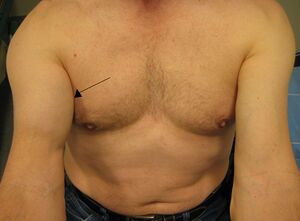Flexion Initiation Test: Difference between revisions
Anas Mohamed (talk | contribs) (Created page with "gusgugxuvsavx") |
Kim Jackson (talk | contribs) m (Text replacement - "[[Biceps brachii" to "[[Biceps Brachii") |
||
| (10 intermediate revisions by 2 users not shown) | |||
| Line 1: | Line 1: | ||
<div class="editorbox"> '''Original Editor '''- [[User:Anas Mohamed|Anas Mohamed]] '''Top Contributors''' - {{Special:Contributors/{{FULLPAGENAME}}}}</div> | |||
=== Purpose === | |||
[[File:Biceps tendon tear.jpeg|right|frameless]] | |||
The '''Flexion Initiation Test (FIT)''' is a diagnostic test for distal [[Biceps Brachii|biceps]] tendon tears. | |||
Image 1: Right distal bicipital tendon rupture. | |||
* Distal biceps rupture is from the excessive eccentric force as the arm is brought into extension from flexion. These activities include weightlifting, wrestling, and labor-intensive job. Risk factors include age, [[Smoking and Exercise|smoking]], [[obesity]], use of [[Corticosteroid Medication|corticosteroids]], and [[Overuse Injuries - an Individualised Approach|overuse]]. | |||
* The incidence of distal biceps [[Tendon Biomechanics|tendon]] rupture is around 2.55 per 100,000 patient-years. Most patients (more than 95%) are males, and injury events usually happen during middle age (35 years to 54 years). Rupture of the distal biceps mainly involves the dominant limb.<ref name=":0">Hsu D, Anand P, Chang KV. [https://www.ncbi.nlm.nih.gov/books/NBK513235/?report=printable Biceps tendon rupture]. StatPearls [Internet]. 2020 Apr 20.Available: https://www.ncbi.nlm.nih.gov/books/NBK513235/?report=printable (accessed 29.9.2021)</ref> | |||
* Another test that can be used is the [[Elbow Hook Test|hook test]] (used to identify the absence of the biceps tendon at its distal insertion).<ref name=":0" /> | |||
=== Technique === | |||
'''Step 1.''' Patient position in sitting or standing position. | |||
'''Step 2.''' Patient’s arm is positioned in complete extension and supination. | |||
'''Step 3.''' Examiner applies resistance on the palmar [[Wrist & Hand|wrist]], then ask the patient to flex the [[Elbow Examination|elbow]] against resistance. | |||
'''Step 4.''' Positive test indicates when patient unable to flex the first 10 to 15 degree of the elbow flexion. | |||
=== Evidence === | |||
In 2021, the Evidence-Based Diagnostic Algorithm study was done in 125 patients. the study shows the flexion initiating test (FIT) has | |||
{| class="wikitable" | |||
!Overall | |||
!Complete tear and high grade partial tear | |||
|- | |||
|sensitivity 93% | |||
|sensitivity 100% | |||
|- | |||
|specificity 96% | |||
| | |||
|} | |||
<small>''See the [[Test Diagnostics|test diagnostics]] page for an explanation of statistics.''</small> | |||
This study also shows: | |||
* Using both hook test and flexion initiating test have high accuracy for examining both complete and high grade partial tear of Distal Biceps Tendon Tears. | |||
* The methodology may help to prevent diagnosis delays, improve patient education, and preserve the option for timely primary surgical repair in the treatment of Distal Biceps Tendon Tears (DBTTs).<ref>Bono OJ, Shah SS, Peterson J, Golenbock SW, Ross G. The Flexion Initiation Test and an Evidence-Based Diagnostic Algorithm for Distal Biceps Tendon Tears. ''Arthrosc Sports Med Rehabil''. 2021;3(3):e721-e726. Published 2021 Mar 13. doi:10.1016/j.asmr.2021.01.010</ref> | |||
{| class="wikitable" | |||
|+ | |||
|} | |||
=== Reference === | |||
<references /> | |||
[[Category:Elbow]] | |||
[[Category:Elbow - Assessment and Examination]] | |||
[[Category:Elbow - Muscles]] | |||
[[Category:Special Tests]] | |||
Latest revision as of 14:54, 10 January 2022
Purpose[edit | edit source]
The Flexion Initiation Test (FIT) is a diagnostic test for distal biceps tendon tears.
Image 1: Right distal bicipital tendon rupture.
- Distal biceps rupture is from the excessive eccentric force as the arm is brought into extension from flexion. These activities include weightlifting, wrestling, and labor-intensive job. Risk factors include age, smoking, obesity, use of corticosteroids, and overuse.
- The incidence of distal biceps tendon rupture is around 2.55 per 100,000 patient-years. Most patients (more than 95%) are males, and injury events usually happen during middle age (35 years to 54 years). Rupture of the distal biceps mainly involves the dominant limb.[1]
- Another test that can be used is the hook test (used to identify the absence of the biceps tendon at its distal insertion).[1]
Technique[edit | edit source]
Step 1. Patient position in sitting or standing position.
Step 2. Patient’s arm is positioned in complete extension and supination.
Step 3. Examiner applies resistance on the palmar wrist, then ask the patient to flex the elbow against resistance.
Step 4. Positive test indicates when patient unable to flex the first 10 to 15 degree of the elbow flexion.
Evidence[edit | edit source]
In 2021, the Evidence-Based Diagnostic Algorithm study was done in 125 patients. the study shows the flexion initiating test (FIT) has
| Overall | Complete tear and high grade partial tear |
|---|---|
| sensitivity 93% | sensitivity 100% |
| specificity 96% |
See the test diagnostics page for an explanation of statistics.
This study also shows:
- Using both hook test and flexion initiating test have high accuracy for examining both complete and high grade partial tear of Distal Biceps Tendon Tears.
- The methodology may help to prevent diagnosis delays, improve patient education, and preserve the option for timely primary surgical repair in the treatment of Distal Biceps Tendon Tears (DBTTs).[2]
Reference[edit | edit source]
- ↑ 1.0 1.1 Hsu D, Anand P, Chang KV. Biceps tendon rupture. StatPearls [Internet]. 2020 Apr 20.Available: https://www.ncbi.nlm.nih.gov/books/NBK513235/?report=printable (accessed 29.9.2021)
- ↑ Bono OJ, Shah SS, Peterson J, Golenbock SW, Ross G. The Flexion Initiation Test and an Evidence-Based Diagnostic Algorithm for Distal Biceps Tendon Tears. Arthrosc Sports Med Rehabil. 2021;3(3):e721-e726. Published 2021 Mar 13. doi:10.1016/j.asmr.2021.01.010







